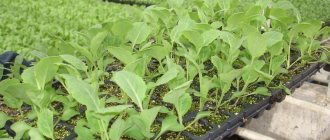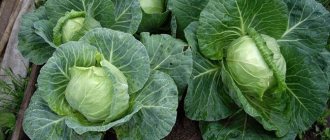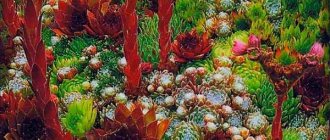A correctly chosen scheme for planting white cabbage varieties is the main condition for obtaining high yields of this vegetable crop. What is taken into account here is the choice of a suitable site for the beds, compliance with the timing and geometry of planting, caring for the emerging seedlings and a number of other important points. Moreover, compliance with such nuances is equally important for both large agro-industrial enterprises and private summer cottages.
Cabbage seedlings in the beds
General requirements
- It is necessary to plant cabbage seedlings in the ground only at consistently above-zero temperatures.
- The soil should warm up to +10…+15°C.
- The beds must be prepared in advance: manure is applied exclusively during autumn digging.
- The holes for seedlings are prepared 10 days before planting the seedlings: the depth is approximately 15 cm, the distance between neighbors is 50 cm.
- Immediately before planting the seedlings, wood ash must be poured into the bottom of the hole.
- The cabbage bed is changed every year; for three years before the season, cruciferous vegetables should not have grown in this place.
- Soil requirements: neutral acidity.
For early cabbage, the planting pattern is 25x25 cm for each bush and 45-50 cm between rows.
For mid-season and late season - 35x35 cm between bushes and 50-55 cm between rows.
Types and varieties
On an industrial scale in agriculture and in amateur gardens, different types and varieties of cabbage are grown, since this vegetable, like potatoes, is one of the most basic. We offer you types and varieties of cabbage for open ground, which you can grow in your dacha or near your house if you wish.
White cabbage
The most common species in our latitudes is white cabbage, which forms a thick, low stem covered with large leaves, as well as a head of cabbage, which is an apical bud that has grown to enormous sizes. Some heads of cabbage reach 16 kg, they are round and dense. White cabbage contains fiber, carotene, vitamins C and B. It is widely used in folk medicine for edema and stomach diseases, and externally for suppuration and boils. The yield of cabbage, as well as its size, depends on the variety: the most productive are the early-ripening varieties Gribovsky and Iyunskaya, the mid-ripening Podarok and Slava, the late Moscow Pozdnyaya and Amager.
Red cabbage
In many ways it is similar to white cabbage, but is more frost-resistant. Its leaves are more purple than red, the heads weighing up to 5 kg are highly dense, so they are stored longer. Red cabbage has two times less fiber than white cabbage, but four times more carotene. It also contains iodine, mineral salts, pantothenic acid, iron, cyanidin, which strengthens the walls of blood vessels. The most common varieties: Gako, Mikhailovskaya, Kamennaya Golovka.
Cauliflower
A dietary product, it is a creamy, granular, tuberculate hemispherical head surrounded by green leaves, weighing up to one and a half kilograms, consisting of rudimentary flowers practically fused together on branched short stalks. The most commonly grown varieties are: early - Movir, Early Gribovskaya, Garantiya, mid-season - Moskovskaya Konservnaya, Otechestvennaya, late - Adlerskaya Zimnyaya.
Broccoli
A variety of cauliflower, its head consists of green or purple inflorescences. It is rich in mineral salts of potassium, magnesium, phosphorus, calcium, vitamins C, A, B1, B2, PP. It has an antioxidant effect and is useful for the prevention of cardiovascular and cancer diseases.
Brussels sprouts
It looks like a long stem on which many small heads grow, similar to the heads of white cabbage. Brussels sprouts are higher in vitamin C than citrus fruits; they are also rich in protein and contain magnesium, phosphorus and folic acid; it increases the body's resistance to disease and improves mental activity.
Savoy cabbage
It has a cabbage shape, but its delicate, highly corrugated leaves of bright green color are curled into a looser head. This type contains more proteins and vitamins than white cabbage.
Kohlrabi
It looks like a spherical stem with leaves on long petioles. Contains large amounts of protein and vitamin C, glucose and calcium.
Chinese cabbage
Today a very popular product on our table. Its head is oblong, loose, the fiber is tender and pleasant to the taste. The leaves contain many useful substances, but its main advantage is that the vitamin C contained in it does not disappear during storage.
Chinese cabbage
A leafy vegetable that does not form a head. In appearance it is more like a salad, but in composition it is close to white cabbage. It contains the essential amino acid lysine, which cleanses the human body of waste and toxins and improves immunity. Chinese cabbage is considered a source of longevity.
Timing for transplanting seedlings
Typically, cabbage seedlings are planted in open ground 45-60 days after sowing the seeds, based on the recommendations for the selected variety. Maturity of seedlings of early cabbage occurs at 55-60 days, for late cabbage - after 35-40 days.
Another important requirement is that the seedlings must have at least 4 true leaves, optimally 6-7.
Depending on the region, seedlings should be transferred at the end of April - early May in the southern regions and in the second half of May - early June in the northern regions.
We plant in the Moscow region, the Urals and Siberia
In the Moscow region, seedlings of early varieties are planted in mid-May, and middle and late varieties - in late May or early June.
In the Urals, there is a high probability of return frosts; the drop in temperature can be prolonged, so seedlings are planted later than in the Moscow region by 1-2 weeks.
According to popular belief, the signal for planting may be the end of the bird cherry flowering. It is believed that after this there are no severe frosts.
When planting early, it is reasonable to provide for the possibility of covering the seedlings with non-woven material in the event of a sudden cold snap.
In Siberia, spring comes 2 weeks later, summer is hot but short. The best time for planting is June 1, when the temperature is above zero day and night.
Fertilizer application
In addition to wood ash, when preparing holes for planting cabbage seedlings, a mixture of organic and mineral fertilizers is used. For organic matter, rotted manure or compost is acceptable; for mineral complexes, superphosphate (20 g per 1 hole).
The easiest way is to feed young plants with a mixture of 1 tbsp. wood ash and 1 tsp. urea.
Among folk remedies, a mixture of ash, crushed eggshells and dry mustard in equal proportions works well. Ash reduces the acidity of the soil, and eggshells along with mustard act as fertilizer and protection against pests.
Preparing the soil for planting
It is better to prepare a place for planting cabbage in the fall.
This crop is demanding on soil fertility and moisture. In the fall, at the site of future planting, humus or compost 10-12 kg per 1 m2, 40-45 g of superphosphate, and a liter jar of wood ash are added to alkalize the soil. Then the area is dug up on the bayonet of a shovel.
Autumn sowing of green manure: vetch, oats, phacelia has a beneficial effect on the condition of the soil. You don’t have to dig them up separately, but in the spring you can cut off the above-ground part and use it to mulch your plantings. The roots are left to rot in the ground to improve the soil structure.
If superphosphate and ash were not added in the fall, they are also added when planting in the spring.
In the future, feed with diluted mullein or plant concentrate.
IMPORTANT! Cabbage is very responsive to organic fertilizers. For medium and late varieties, you can add 6-8 kg of manure per 1 m2 in the fall.
For early cabbage, the permissible norm is two times less, since it is prone to the accumulation of nitrates.
Neighbors and predecessors
Considering that growing cabbage requires quite a lot of space, other plants are often planted in the beds between the heads of cabbage.
Good neighborhood
To increase productivity, the following are planted between rows of cabbage:
- potato;
- spinach;
- salad;
- cucumbers;
- beans.
To repel pests:
- onion;
- dill;
- celery;
- sage;
- rosemary.
Bad neighbors
A number of plants are incompatible with cabbage due to the possibility of infection by the same pests and diseases.
Do not plant next to cabbage:
- tomatoes;
- parsley;
- pepper;
- cabbage;
- strawberries
Predecessors
It is not recommended to plant cabbage in one place every year. The optimal period is once every three years. If the area is limited, then you can alternate planting cabbage and green manure:
- peas:
- wiki;
- lupine
For cabbage, mustard is never used as green manure.
Cabbage is not grown after other cruciferous vegetables: radishes, radishes, turnips.
Plant compatibility in the garden
In order for some crops to have a beneficial effect on their neighbors in the garden, experienced gardeners organize mixed plantings of vegetables.
Mixed plantings improve vegetable yields
It should be noted that you need to take into account some subtleties when choosing plants:
- the timing of ripening of different crops so that the soil is not bare;
- differences in height and development of the root system (deep, shallow);
- similar watering needs.
The best neighbors for cabbage are lettuce, peas, potatoes, corn, onions, cucumbers, parsley, leaf celery, radishes, melon, and spinach.
The best neighbors of cabbage are peas, lettuce, potatoes, etc.
I came across an article by N. M. Zhirmunskaya “Good and bad neighbors in the garden bed.” Having become interested in this topic, I spent a long time studying the subtleties and nuances of the issue. Then, for two years, I tried to apply this planting algorithm at my dacha. Not everything worked out right away as I would have liked. Today I can note that I learned how to plant plants by mixing different vegetables, flowers and herbs. Thus, I get combined plantings of main crops and additional ones, which create a favorable environment, increase resistance to disease and even affect the taste of the fruit. When using this method, the soil is protected from weeds and drying out, and the number of pests is significantly reduced, since the smell of strong-smelling neighbors repels insects. I plant lavender, marigolds, calendula, oregano, basil, sage, wormwood and peppermint along the edges of the beds and around the perimeter of the vegetable garden. In addition, it creates an ideal refuge for predatory insects, spiders and frogs that feed on pests. This does not mean that they disappear completely, the main thing is that they do not cause significant damage. Last year I was once again convinced that early cabbage and tomatoes, late cabbage and early potatoes, tomatoes and celery, beans and potatoes feel good next to each other. From the above, I can conclude that the main functions of using the correct neighborhood are:
- rational use of land;
- protection from diseases and pests;
- no soil depletion;
- increasing productivity.
You will have to work hard to create such beds, but the results will not disappoint you.
Hardening
Before planting seedlings in the ground, seedlings go through a hardening stage. This reduces the risk of stress when adapting to a new place. Hardening begins 10 days before transplantation.
- For 2 days, the seedlings are left in a room with an open window for 4-5 hours.
- Over the next 3 days, the boxes are taken out to a glassed-in loggia or other cool room.
- Along with the decrease in air temperature, watering is reduced.
- From the 6th day, the seedlings are taken out to the balcony and left there until the day of transplantation.
Preparation of planting material
For planting, choose clean, healthy seeds without damage, stains or signs of mold. They are soaked in a fungicide solution for ten minutes. Use the drugs Vitaros, Maxim or others. As an alternative, you can use a pink solution of potassium permanganate.
Then the planting material is washed and hardened - kept in warm water, and then in cold water. To increase germination, you can treat them with Epin, Zircon or another growth stimulant.
Transfer
- Prepare a hole: depth 15 cm, width slightly larger than the earthen ball around the root system.
- Remove the seedlings from the cups by transferring them, being careful not to disturb the roots.
- Pour at least 1 liter of water into the hole. For prevention, add Fitosporin-M in a standard dosage.
- Bury the seedling to the cotyledon leaves.
- Sprinkle with soil without compacting.
- Make a small hole around the stem part.
Important: as a preventive measure against mole crickets, pour tar solution into the hole at the rate of 1 tbsp. on a bucket of water. The liquid should be absorbed. It is unacceptable for this solution to come into contact with the plant.
Site selection and soil preparation
The cabbage bed should be in a sunny place with a deep groundwater level. The vegetable loves soil with neutral acidity. Acidic soil and high humidity provoke clubroot infection.
A week before planting, treat the soil with a solution of Fitosporin at the rate of 1 tablespoon per 10-liter bucket of water, and after it sprinkle the soil with wood ash. This will protect the plant from fungus, reduce acidity and create a favorable nutrient environment.
Be sure to follow crop rotation. Cabbage should not be planted after cruciferous vegetables - mustard, turnips, radishes, radishes and cabbage itself. The best predecessors are legumes, nightshades, carrots, garlic and cucumbers.
Planting white cabbage
White cabbage is planted in holes at a distance of 30 cm between the bushes. The approximate depth of the holes is 12 cm.
Fertilizer is applied: 300 g of peat, 1 glass of ash. You can use superphosphate, but only if the seedlings were not fertilized several days before transplanting.
At least 1 liter of water is poured under each bush. It is better if the seedlings are transferred to earthen slurry.
If the soil is moist enough, you can replant without additional watering. In this case, the white cabbage seedling must be buried so that the growing point is above the soil level.
Planting without seedlings
Cabbage is a cold-resistant plant, which allows it to be grown without seedlings. At the same time, the seedlings are hardened naturally, acquire strong immunity and form denser heads of cabbage.
The disadvantage of this method is the high consumption of seeds. You will need one and a half to two times more of them than with the seedling method. During cultivation, some seedlings may not sprout; some will need to be removed during the thinning process.
Seeds are planted in furrows or holes 2-3 cm deep. Up to five seeds are placed in one hole, and one seed every 10 cm in the furrows. After planting, the bed is sprinkled with a mixture of peat and humus and covered with agro-fabric or film. If you use film, make several holes in it to allow air to enter. The seedlings are kept under such a greenhouse for one month with regular ventilation and loosening.
The first thinning is done after the stems grow to 10-12 cm and 3-4 leaves appear on them. It is necessary to remove all weak and thin sprouts, leaving two strong stems in each place. After some time, a second thinning is done, leaving the strongest plant of the two. Removed seedlings are transplanted to a separate bed.
Cauliflower
A bed for cauliflower is prepared based on the distance between rows of at least 60 cm, between individual plants - 30 cm.
Fertilizers are required for this variety. Optimally - a mixture of ammonium sulfate, superphosphate, potassium salt and chalk.
Among the folk remedies, bird droppings mixed with humus are suitable for cauliflower.
Less water is required per hole than for white cabbage: 0.5-0.7 liters. The seedlings are transferred to the soil after the liquid is completely absorbed into the ground.
Tips and recommendations from experienced gardeners
Those who have grown white cabbage in the countryside note that there are several techniques that will improve the quality of planting seedlings or seeds in open beds.
For example, if the seedlings have outgrown and become too large, when planting the plants, you need to tear off the upper halves of the leaves. This way they will settle down faster and get sick less. But this must be done carefully so as not to accidentally cut off the growing point, otherwise there will be no heads of cabbage.
You need to plant strictly 1 plant in each hole, and when sowing seeds, leave only one. Otherwise, cabbages growing together will have small and ugly heads.
Slightly frozen plants due to return frosts can be sprayed with Epin or Novosil solutions.
We recommend reading
What varieties of cabbage to choose for pickling, pickling and storing for the winter
How can you feed cabbage after planting in the ground?
Methods for storing cabbage in the cellar and at home
Methods, terms and conditions for storing cauliflower
Kohlrabi
For this variety, the general rules for planting cabbage in the ground remain the same. One of the nuances is feeding. Kohlrabi seedlings respond gratefully to adding a mixture of superphosphate (2 tbsp), urea (1 tsp) and ash (2 cups) into the hole.
It is important to plant kohlrabi in small holes. Their depth should not exceed the depth of the cup in which the seedlings were grown.
You can skip pre-watering the holes. The seedlings are watered after the earthen clod has been sprinkled.
Important: the growth point of kohlrabi seedlings is never buried, as the plant may stop growing and bloom.
Preparatory activities
Prepare a place for growing cabbage in the fall. During this period, a site is selected and the soil is processed. In the spring, beds are formed and events with seedlings are held.
How to choose a site?
Any type of cabbage loves plenty of sun and hates thick weeds. Choose a place that is lit throughout the day and where perennial grasses do not grow (the permissible norm per 1 sq. m is 3 weeds).
An important indicator is the soil horizon, which has an average or high level of fertility. If the future site does not meet this criterion, the situation is corrected by applying fertilizers in the fall and spring.
Pay attention to the depth of groundwater - it should be 1 or more meters.
Features of crop rotation
Compliance with the rules of crop rotation contributes to the rapid formation of the root system, since the soil contains all the necessary microelements.
Additionally, plants are protected from pests and diseases because cabbage is planted in areas where crops that were previously attractive to other types of insects and infections grew.
Best predecessors:
- potato;
- green manure;
- beans;
- peas;
- zucchini;
- cucumbers
It is permissible to plant cabbage after corn, onions, garlic, herbs, salads and early varieties of cabbage. It is strictly forbidden after the following:
- pumpkin;
- any pepper;
- tomatoes;
- carrot;
- radish;
- eggplant;
- beet;
- late and middle cabbage.
Cabbage grows well next to other vegetables, which allows for further improvement of conditions. What should be next to:
- to increase productivity - spinach, beans, cucumbers, potatoes, lettuce;
- to repel pests - dill, onion, rosemary, sage, celery.
Never plant cabbage next to peppers, parsley, tomatoes and strawberries.
Preparing the bed
Start work in the fall, after the previous harvest has been harvested. What to do:
- Remove all plant debris, grass, fallen leaves and debris from your garden.
- Dig to a depth of 30-35 cm.
- Along with digging, add organic fertilizers. For 1 sq. m take 5-6 kg of compost or rotted humus.
Spring activities include the following:
- Again, clear the area of debris and last year's remains of leaves and branches.
- Dig up according to the same principle as in the fall, adding fertilizer. For 1 sq. m – 200 g of wood ash, 1 tbsp. l. preparation of Superphosphate and nitrate.
- Level the ground surface.
- Make holes taking into account the planting technique. The depth is 15-18 cm, the width is slightly larger than the volume of a single container with seedlings.
- Place 1 tsp of fertilizer into each cavity. Nitroammofoski, 1 tbsp. l. wood ash, 300-500 g of compost, some soil for mixing.
If the soil in the garden is fertile, you don’t need to add fertilizer to the hole.
Hardening of seedlings
The procedure is necessary to facilitate adaptation and speed up survival. If you do not harden the seedlings, they begin to get sick, resulting in an increased risk of death. How to do it correctly:
- 10-14 days before transplantation, open the window for the whole day so that there is no draft.
- On the second day, take it outside for 2 hours.
- On the third day, leave in fresh air for 4 hours.
- On the fourth - for 6 hours, etc., until the plants are in such conditions around the clock.
The place should be sunny, the daytime temperature should be at least +5°C.
Preparing seedlings for direct planting
These activities are needed for the same purposes as hardening, plus they help strengthen the immune system and facilitate the transplantation process. Follow these steps:
- 12-14 days before transferring to open beds, fertilize. To do this, mix potassium sulfate and urea in 10 liters of water (1 tablespoon is enough). Pour 120-150 ml of solution under each bush.
- 3 days before the transplant procedure, stop moistening, which will make the stem drier and stronger. This reduces the risk of breakage.
- Water the seedlings 1 day in advance to make it easier to remove from containers.
If the transfer technique is used, do not moisten the soil and stop watering 2 days in advance.
Broccoli
Broccoli is planted according to a 35x60 cm pattern. The holes are made small so that the seedlings are no deeper than they grew in the cups.
Watering the holes only in dry weather. Remember that broccoli does not like to be over-watered.
For feeding, it is better to use a folk remedy - a mixture of humus, compost and ash at the rate of 1 handful of each component per 1 hole.
After transplanting, the seedlings are watered and the holes are mulched.
Mulch protects fragile seedlings from overheating and weed growth.
Growing seedlings in greenhouses and greenhouses
Seed material must be calibrated and processed before planting. This is necessary in order to prevent the negative effects of pathogens and pests. Proper preparation is the key to high immunity. Disinfection is carried out using a solution of potassium permanganate.
The scheme is drawn up based on the approximate plan of agrotechnical measures. If the gardener decides not to pick, at least 5 cm should be left between the seeds. If this point is present, the optimal distance is 3 cm. Planting depth is from 2 to 4 cm.
If the required temperature conditions are met, seedlings will appear 4 days after planting. They need to be pollinated with wood ash. During the day in the greenhouse it should be from +15 to +17 °C, at night - no more than +9 °C.
How to plant overgrown cabbage seedlings in the ground
It happens that cabbage seedlings cannot be planted in the ground on time. The seedlings stretch out and weaken. As soon as conditions allow, they need to be replanted, giving the plants shock therapy.
- The holes are made 3 cm deeper than the earthen ball, and the plants are deepened to the cotyledon leaves.
- After removing the seedlings from the cups, the root is trimmed, leaving only half its length.
- The holes are not watered before planting. The planted seedlings are only slightly moistened.
In conditions of limited soil moisture, plants will slow down and devote all their energy to growing the root system.
Cleaning and storage
Three weeks before harvesting, stop watering the cabbage - this measure stimulates the accumulation of fiber in the forks, which contributes to better storage of the cabbage. When the night temperature drops to -2 ºC, harvesting can begin. Do not delay harvesting, because at lower night temperatures the heads of cabbage freeze, which negatively affects their keeping quality. Dig up the cabbage along with the roots, sort it, putting aside small heads eaten by beetles or touched by rot - this cabbage cannot be stored, you will have to eat it or pickle it. Storable cabbage is placed under a canopy for a day so that it dries and slightly winds, then its stalks are cut off 2 cm below the head, leaving 3-4 covering green leaves on it. Now the cabbage can be placed in storage.
It is best to store vegetables in the cellar - there is usually high humidity and the temperature does not drop below zero. If the temperature in the cellar does not rise above 4-6 ºC in winter, then this is an almost ideal storage for cabbage, since the optimal conditions for storing cabbage heads are air temperature from -1 to +1 ºC, and humidity from 90 to 98%. But first you need to put the room in order: there should be no mold on the walls, despite the high humidity, and no debris on the earthen or cement floor. It is advisable to whitewash the walls with a solution of quicklime, after which the cellar is fumigated with sulfur. Make sure there is good ventilation as well. If there is no ventilation system, you will have to ventilate the cellar well at least once a month.
Cabbage is stored in a single layer on racks, as well as in a folded pyramid on wooden boards or hanging, wrapped in newspaper.
In order to keep cabbage fresh for as long as possible, gardeners resort to some tricks that we are ready to share with you:
- You can tie the heads of cabbage in pairs by the stalks and hang them from the ceiling on poles. In this position, there will be air access to the heads, they can be easily inspected for damage;
- store cabbage in lattice wooden boxes placed on stands or shelves - the main thing is that they do not stand on the floor;
- the heads of cabbage wrapped in paper are placed in a plastic bag without tying it and hung from the ceiling or placed on a shelf;
- The head of cabbage is placed in a ten-liter bucket of soil, then it is covered with earth on top and the bucket is placed in the cellar. Sand can be used instead of soil.
There are a couple more storage methods, but for them the root of the cabbage is not cut off, and the covering leaves, on the contrary, are removed. After this, the heads of cabbage are hung by the roots in a draft and slightly withered. When the top leaves dry, the heads of cabbage are moved to the cellar and, tied in twos, hung by the roots from the ceiling. Or they immerse the head of cabbage in a clay mash of the consistency of pancake batter (cabbage leaves should not be visible through the layer of clay), then allow the clay to dry, hanging the head of cabbage, and take it to the cellar, where they also hang it from the ceiling. We have described to you ways to store white and red cabbage. Cauliflower is stored only in a suspended state, having previously wrapped the heads in paper.
You can, of course, store cabbage in the refrigerator, wrapped in a paper towel and placed in a loosely tied bag, but there is not much space in the vegetable department, and the shelf life of cabbage in the refrigerator is no more than two months.
Care after transplant
Watering
Cabbage prefers frequent watering and does not tolerate drought. Even a slight increase in air temperature can cause rapid loss of moisture.
The optimal regime is watering once every 2-3 days in hot weather and once a week in rainy weather.
The rate of watering depends on the size of the plant. Seedlings transplanted into the ground require 2 liters per bush, adult plants - 5 liters per specimen.
Loosening
After each watering or rain, the soil around the cabbage is loosened. This ensures free air exchange in the root zone. After loosening, make a watering circle around each plant.
Feeding
When growing cabbage in open ground, two feedings are recommended.
- 2 weeks after transplanting the seedlings to a permanent place.
- 2 weeks after the first application of fertilizers.
It is recommended to use mineral complexes. Among folk remedies, a mixture of mullein and chicken droppings or a herbal infusion works well. To do this, mullein and droppings are diluted in equal proportions with water in a ratio of 1:10.
Herbal infusion is made from crushed nettle or dandelion. The greens are poured with water, ash and yeast are added at the rate of 1 bucket of ash and 1 kg of live yeast per 100 liters of water. All infuse for a week and water 0.5 liters per plant.
To protect against insects, cabbage is dusted with wood ash.
Diseases and pests of cabbage.
Cabbage is not planted in the same place every year to avoid diseases. In open ground, it can be affected by clubroot from excess moisture. If agricultural practices and crop rotation rules are violated, it is affected by white and dry rot.
Cabbage pests that can often be found are the cruciferous flea beetle and aphids. Cabbage leaves are eaten by the cabbage cutter and the white caterpillar - green caterpillars. To combat diseases and pests of cabbage, preparations from garden stores or folk remedies are used.
Dusting cabbage with tobacco dust and ash helps against cruciferous flea beetles. Among the drugs used, for example, Aktar. Bitoxibacillin is effective against cabbage cutworm, as well as Alatar, Fufanol - Nova. The drug Aliot, Alatar will help get rid of the white butterfly caterpillars.
Watch the video: How to get rid of slugs and snails when they attack your garden











